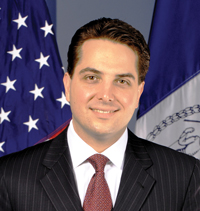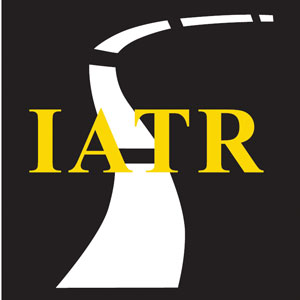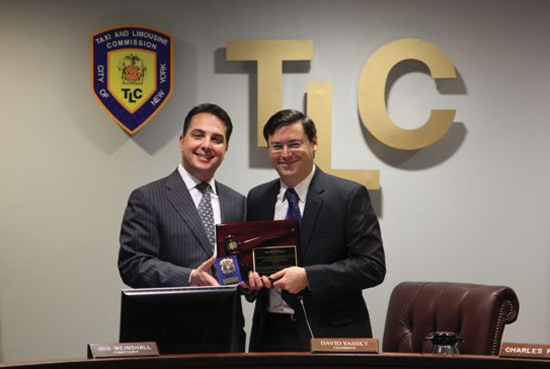 IATR — IN FOCUS
IATR — IN FOCUSPresident, International Association
of Transportation Regulators
Distinguished Lecturer, University Transportation Research Center, Region 2


 IATR — IN FOCUS IATR — IN FOCUS |
||
| by Matthew W. Daus, Esq. President, International Association of Transportation Regulators Distinguished Lecturer, University Transportation Research Center, Region 2 |
 |
 |
New TLC Chair Yassky Honors Matt Daus
Daus Keynotes Nanotechnology Conference of Hedge Fund and Enviro-Tech Companies with former U.S. General Wesley Clark & U.S. Postal Services Commissioner Ruth Goldway
First of all, I would like to sincerely thank new TLC Commissioner David Yassky, the Board of Commissioners and TLC staff for welcoming me back on November 16th to present me with an award and my “laminated” official City badge. It was truly an honor to see my friend David in action as well as some old and new friends and colleagues. It was a unique experience sitting in the audience at a TLC Commission meeting offering me a very different perspective.
I had not missed a Commission meeting in over 14 years in my consecutive roles as TLC General Counsel and then Chair until I recently left the TLC in April of this year. I received a beautiful plaque with a mounted gavel that acknowledged my accomplishments and many years of public service. It was also good to have my trusty badge back which had been with me through the dark days following 9/11 and throughout my entire 8 ½ years as TLC Commissioner. It now sits atop a new mound of paperwork on my desk including legal briefs, bills, graduate student papers and research. Thank you Commissioner Yassky! Your thoughtfulness is appreciated, and I know you will bring the TLC to new heights and even greater accomplishments ahead.

New TLC Chair David Yassky and the TLC's Board of Commissioners honored former TLC Chair Matthew Daus at their November public meeting presenting him with his laminated City badge and a plaque mounting his gavel acknowledging his "historic and compassionate leadership" of the TLC.
Nanotechnology Conference
On December 7th, I was further privileged to be a keynote speaker, along with former U.S. General Wesley Clarke and U.S. Postal Services Commissioner/Chair Ruth Goldway, at a Nanotechnology conference hosted by Livingston Securities, and its innovative founder, Scott Livingston. The conference was attended by business leaders, investors, hedge fund managers and environmental technology companies.
My keynote speech included a detailed history of the introduction and demise of electric vehicles in NYC and the taxicab industry, from inventions in Scotland and France to the first taxi fleet of Electrobats or electric hansom cabs.
I spoke of the events that started in 1914 which led to the demise of the electric vehicle including the need for fast vehicles with the onset of World War I, the invention of the electric starter, and Thomas Edison’s failed nickel-iron battery experiment and partnership with Henry Ford to produce an electric Model-T.
I also chronicled my prior efforts with Mayor Bloomberg to introduce one of the largest clean air vehicle fleets in the country, NYC’s taxicabs, which boast over 4000 hybrid-electric vehicles that already have and continue to reduce carbon emissions by over 64,000 tons per year. In the taxicab realm alone, if 25 of the 40 cities that are part of the C40 Coalition which is led by Mayor Bloomberg to reduce greenhouse gases globally converted their 1 million taxicabs simply to hybrid-electrics, this would lead to a significant carbon emissions reduction of 16 million tons of CO2 (carbon dioxide) annually.
I provided this entrepreneurial crowd with some insight into the use of nanotechnology to provide for more fuel efficient vehicles through electric battery and ethanol production. About 5 billion gallons of ethanol are produced in the U.S. each year made from corn and sugar cane for use with both flex fuel vehicles and reformulated gasoline where ethanol is used as a fuel additive to add oxygen to the petrol formulation.
In order to reduce our dependence on foreign oil the U.S. plans to increase production to 35 billion gallons over the next ten years. The problem we have is that only corn cornels can be fermented to produce ethanol and not their more plentiful corn stalks which are made of cellulous. However, nanotechnology research on the molecular structure and function of bacteria can lead to the modification of enzymes that are necessary to convert sugar into starch so that corn stalks, wood chips, grasses and most plant material comprised of cellulous can also be used to produce ethanol.
With regard to battery technology, nanotechnology can help to make batteries lighter as well as provide them with more power and less recharging time. This is accomplished by coating the battery’s electrode with nanoparticles creating a larger electrode surface thereby increasing the flow of current between the chemicals stored in the battery and the electrode itself. Doing so solves one of the most significant issues that evades the widespread use of zero emission electric vehicles namely, that the weight of the battery itself at some point works against fuel efficiency slowing the vehicle and not allowing for more spacious automobiles. One example of this nanotechnology is a lithium ion battery which was just recently unveiled as part of an electric plug-in version of the Ford Transit Connect at the Chicago Auto Show this year.
Responsible Hospitality Institute (RHI) Webinar on Nighttime Transportation
Finally, last month I participated in a webinar on behalf of the IATR with Jim Peters of RHI, Blair Davies from Australia, and Marc Halat from Calgary, Alberta. We discussed the logistics problems and safety issues facing late night ground transportation in our respective countries. Discussion focused on not only public/private partnerships to provide for taxicab or shuttle stands staffed with dispatchers, but also the concept of taxi group riding, the use of GPS dispatch technology, and even the use of government transportation subsidies to offset the expense of such services as most night time public transportation options are diminished in the late evening hours.
The safety and orderly dispatch of adequate ground transportation upon the mass closure of nightclubs and the management of entertainment zones is important to saving lives as the availability of transportation options discourages patrons from driving their own vehicles while intoxicated.
Many thanks go to Jim Peters who leads the influential RHI, and to the IATR’s Membership Services Director, Karen Cameron, for forging such a productive relationship. Our work with RHI only recently started with this Webinar, but it will continue with our participation at a national hospitality summit in Washington, D.C. next March, and as part of the IATR’s 2011 Conference in Toronto where our theme will be “Education and Hospitality.”
